Deep Red Navajo Indian Rug from Ganado Trading Post - C3894
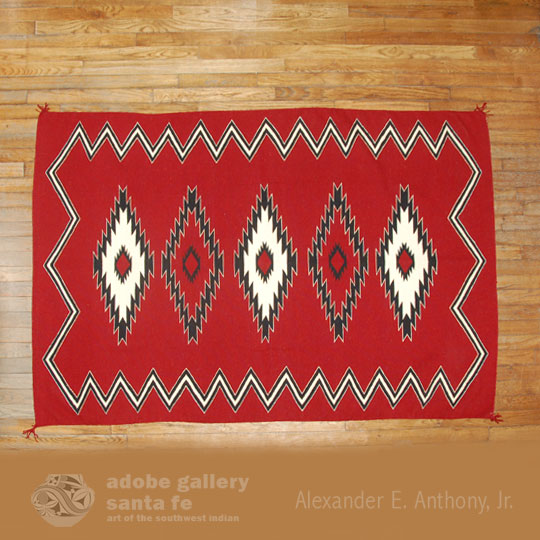 Ganado Trading Post was established in the mid-1870s by John Lorenzo Hubbell at what became known as Ganado, Arizona. The trading post is located about 53 miles northwest of Gallup, New Mexico. It is the oldest trading post in existence and was purchased from the Hubbell family in the 1960s by the United States Government and operations continue as before, with only a change in management.
Ganado Trading Post was established in the mid-1870s by John Lorenzo Hubbell at what became known as Ganado, Arizona. The trading post is located about 53 miles northwest of Gallup, New Mexico. It is the oldest trading post in existence and was purchased from the Hubbell family in the 1960s by the United States Government and operations continue as before, with only a change in management.
Hopi Pueblo Cottonwood Eagle Katsina Doll - C3475D
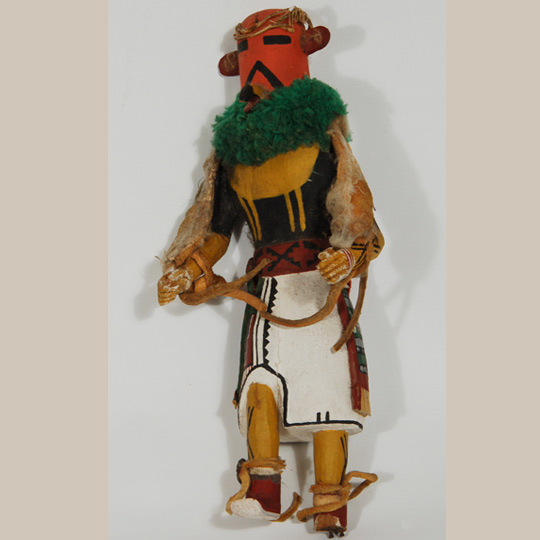 The Eagle katsina appears in the spring dances, the Kiva and the Repeat Dance. Eagles occupy a unique place in the pantheon of Hopi deity. They are treated as family members and honored guests, given presents as are Hopi children, and ritually fed and cared for until the ritual smothering in the spring, whereupon the bird is plucked of its feathers for use in holy rituals.
The Eagle katsina appears in the spring dances, the Kiva and the Repeat Dance. Eagles occupy a unique place in the pantheon of Hopi deity. They are treated as family members and honored guests, given presents as are Hopi children, and ritually fed and cared for until the ritual smothering in the spring, whereupon the bird is plucked of its feathers for use in holy rituals.
This carving appears to be pre-1950s based on style and paints. The neck ruff is wool yarn and there are leather strips tied to each arm on which there once was a spray of feathers and white cotton. Over the years, both feathers and cotton are gone. There is a yucca or grass head band, most of which is still intact.
Would you like to know more or purchase?
Historic Cochiti Pueblo Historic Olla with Rainbow Designs - C3466A
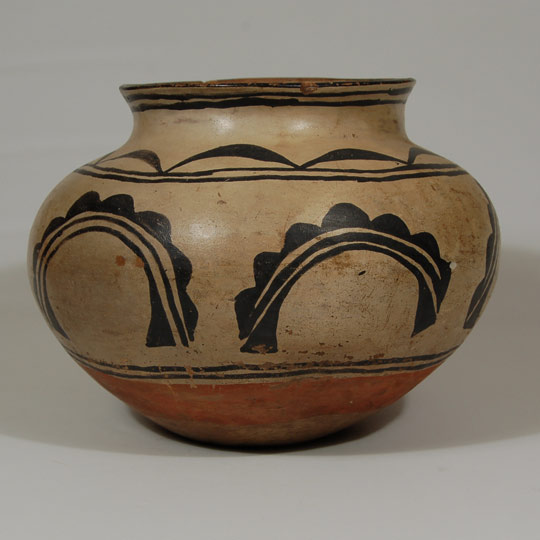 This is a superb olla from Cochiti Pueblo, dating to late 1800s, probably 1880s. It is typically Cochiti in all technical aspects: crystalline-rock temper in the paste, stone-polished, bare-paste underbody, black rim top with red neck interior below the designed area, rag-wiped bentonite slip and black vegetal paints. Even without the specifics of construction and materials, this vessel is positively identifiable as Cochiti in origin.
This is a superb olla from Cochiti Pueblo, dating to late 1800s, probably 1880s. It is typically Cochiti in all technical aspects: crystalline-rock temper in the paste, stone-polished, bare-paste underbody, black rim top with red neck interior below the designed area, rag-wiped bentonite slip and black vegetal paints. Even without the specifics of construction and materials, this vessel is positively identifiable as Cochiti in origin.
The fantastic round shape of the pottery vessel, with its widest point at mid-body, suggests the form of many Cochiti jars. The black vegetal design motifs, painted in the traditional Cochiti style, reflect the loose, gestural, almost haphazard organic and free application.
Would you like to know more or purchase?
Hopi Pueblo Small Polacca Polychrome Dish by Nampeyo of Hano - C3893A
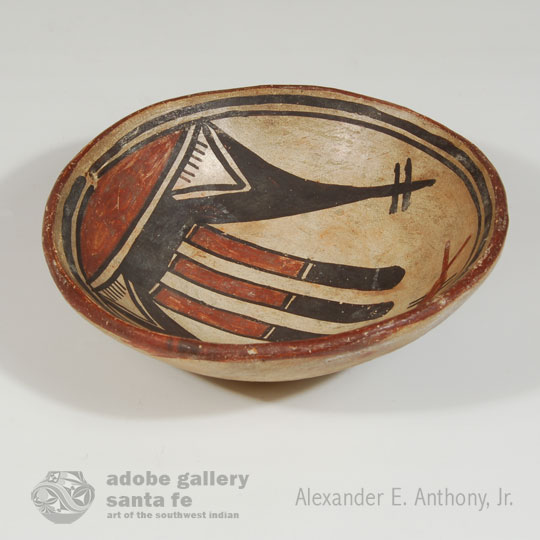 This exquisite small dish, with a strong and vivid design, is attributed to Nampeyo of Hano based on several considerations-construction techniques, selection of clay, layout of design, and execution of design. The material is known at Polacca slip and was in use by Nampeyo early in her career, such as 1880-1900. Polacca slip crazes over time to form cracks as in a dry river bed. The design with the top deep red section is quite typical of her designs. It serves as the anchor for the design appended below it. She used this technique in open bowls.
This exquisite small dish, with a strong and vivid design, is attributed to Nampeyo of Hano based on several considerations-construction techniques, selection of clay, layout of design, and execution of design. The material is known at Polacca slip and was in use by Nampeyo early in her career, such as 1880-1900. Polacca slip crazes over time to form cracks as in a dry river bed. The design with the top deep red section is quite typical of her designs. It serves as the anchor for the design appended below it. She used this technique in open bowls.
Original Oil Painting of Summer Bird by Will Shuster - 25320
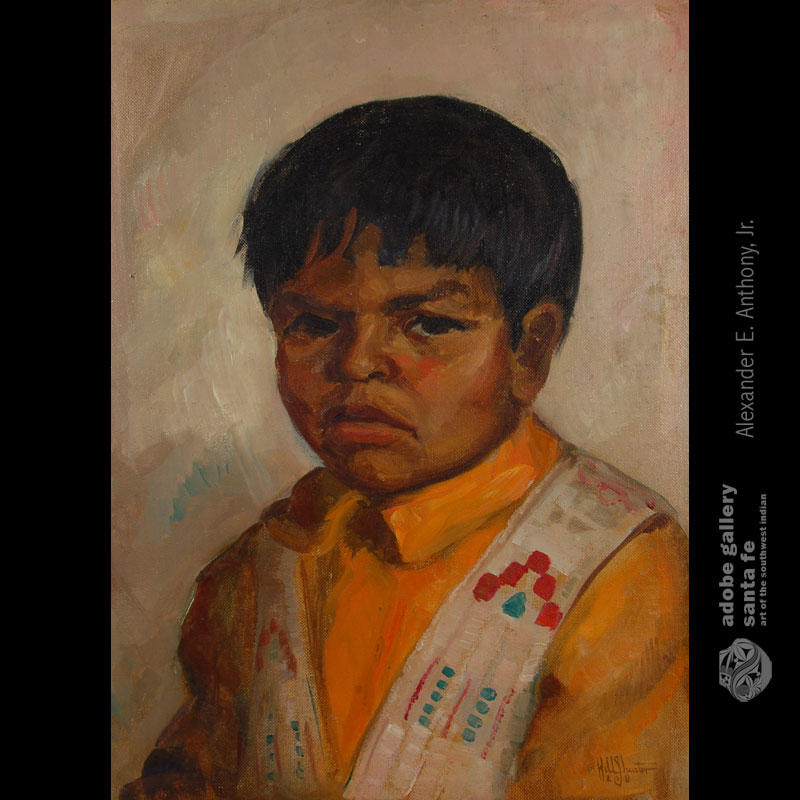 By-o-toi-ti was a young lad from San Ildefonso Pueblo that Will Shuster chose as a subject for this painting in 1928. It is an extraordinary portrait of the young boy. I think the boy was less than enthusiastic about dressing up and posing for the painting. His almost pouting expression is part of the charm.
By-o-toi-ti was a young lad from San Ildefonso Pueblo that Will Shuster chose as a subject for this painting in 1928. It is an extraordinary portrait of the young boy. I think the boy was less than enthusiastic about dressing up and posing for the painting. His almost pouting expression is part of the charm.
A realist and early modernist painter, graphic artist, illustrator, and sculptor, Will Shuster became known primarily for his work in New Mexico where, in 1920, he settled in Santa Fe, having been encouraged to come there by John Sloan. He had studied electrical engineering at the Drexel Institute in Philadelphia and later was a student of Sloan\'s in Santa Fe in both etching and painting.
Would you like to know more or purchase?
Hopi Pueblo Action Style Deer (Sowi-ing) Katsina Doll - 25800
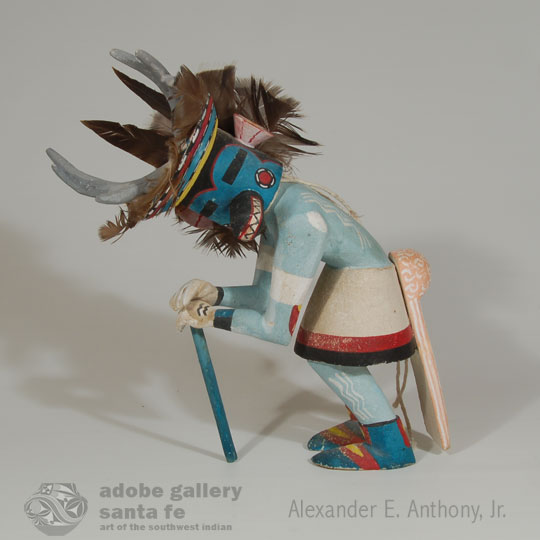 It is believed by the Hopi that Katsinas embody the spirits of living things and the spirits of ancestors who have died and become a part of nature. It is believed that Katsinas possess powers over nature. Katsinas are personated by men of the village and, in doing so, they become the supernatural with all the powers associated with the supernatural Katsinas. As supernatural beings, they may cure disease, grow corn, bring clouds and rain and reinforce discipline and order in the Hopi world.
It is believed by the Hopi that Katsinas embody the spirits of living things and the spirits of ancestors who have died and become a part of nature. It is believed that Katsinas possess powers over nature. Katsinas are personated by men of the village and, in doing so, they become the supernatural with all the powers associated with the supernatural Katsinas. As supernatural beings, they may cure disease, grow corn, bring clouds and rain and reinforce discipline and order in the Hopi world.
Animal Katsinas, in addition to possessing those functions, have the power to strengthen the chance of abundant animals for hunting season. Hunting animals for the Hopi is not a sport but a necessity for provisions for the winter. There are Katsinas representing Deer, Antelope, Rams and other hunt animals. This doll carving represents the Deer Katsina.
Would you like to know more or purchase?
Santa Clara Pueblo Mineral Earth Painting of a Beaver by Pablita Velarde - C3224AK
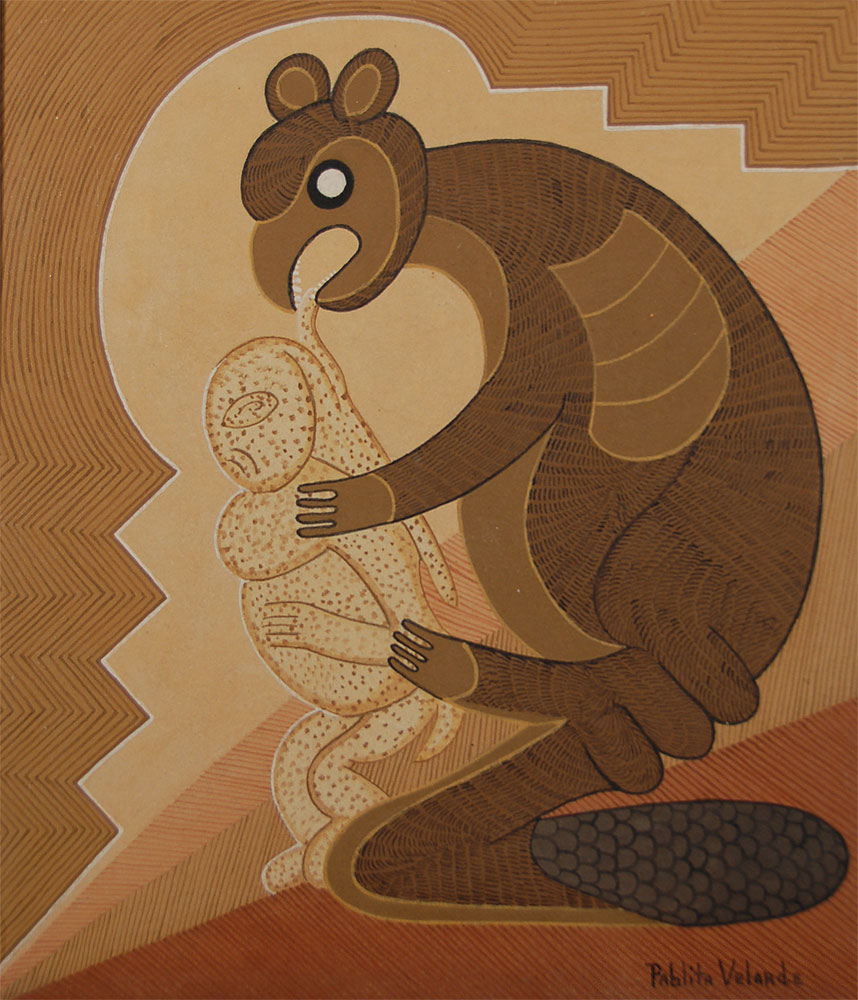 Pablita Velarde (1918-2006) Tse Tsan - Golden Dawn worked in water-based paints from time to time but she is best known and internationally recognized for her paintings rendered in her own hand-made paints from mineral sources. She would first draw her designs on Masonite panels that were treated with a coat of pumice. She then used her ground-up minerals as paint to fill in the areas she had drawn. To mix her paints, she combined the pigment with water and glue, and then painted with paintbrushes. She would paint each color up to seven layers to gain the consistency she desired. She then would outline the images, once again as many as seven or so times, to insure they were strong black.
Pablita Velarde (1918-2006) Tse Tsan - Golden Dawn worked in water-based paints from time to time but she is best known and internationally recognized for her paintings rendered in her own hand-made paints from mineral sources. She would first draw her designs on Masonite panels that were treated with a coat of pumice. She then used her ground-up minerals as paint to fill in the areas she had drawn. To mix her paints, she combined the pigment with water and glue, and then painted with paintbrushes. She would paint each color up to seven layers to gain the consistency she desired. She then would outline the images, once again as many as seven or so times, to insure they were strong black.
Polychrome Wedding Vessel with Sun Face by Lela and Van Gutierrez - C3672G
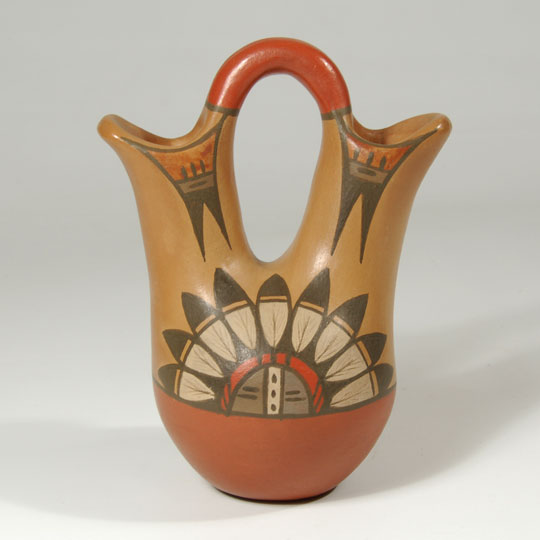 It is often thought that the wedding vessel was a creation by potters to satisfy a tourist market but Teresita Naranjo of Santa Clara Pueblo stated that they were actually used in the pueblo, although she was not aware that they had been used since around 1935.
It is often thought that the wedding vessel was a creation by potters to satisfy a tourist market but Teresita Naranjo of Santa Clara Pueblo stated that they were actually used in the pueblo, although she was not aware that they had been used since around 1935.
This Southwest Indian Pottery wedding vessel was executed in the traditional manner of Lela and Van Gutierrez with the design executed in multiple colors of natural materials. There is a half sun face on both sides of the vessel. The sun rays are rendered as feathers.
Diné - Navajo Sterling Silver and Turquoise Concha Belt by Billy Goodluck - C2925K
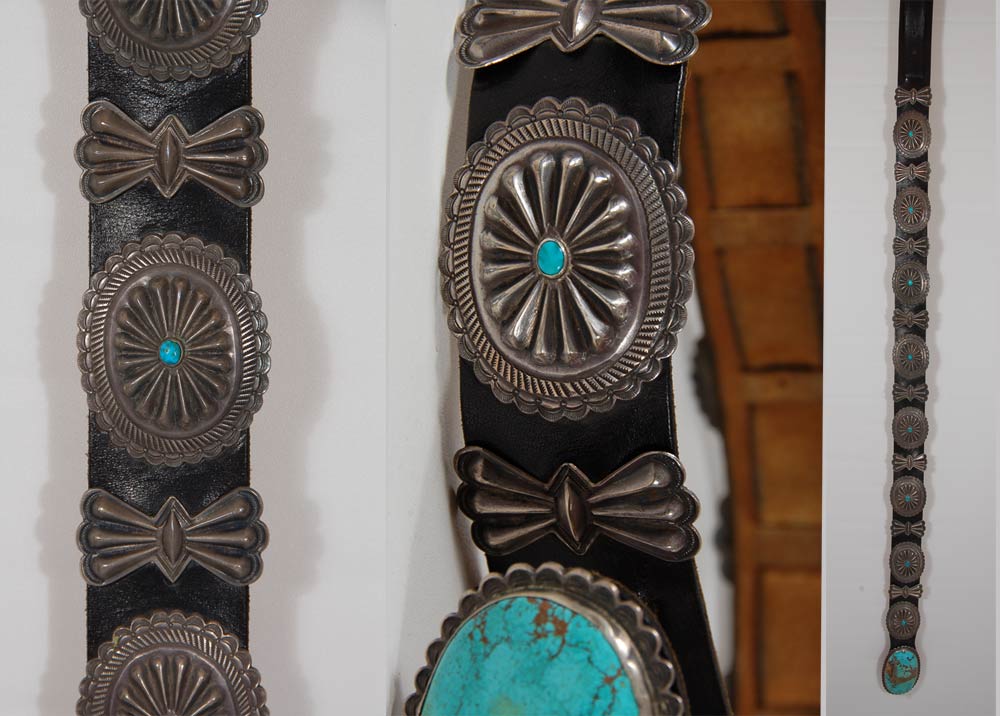 In the early twentieth century, banks were non-existent on the Navajo Reservation. As a result, the Navajo tended to invest their wealth into jewelry and if they needed money, they could pawn the jewelry at the local trading post. One popular form of jewelry that is distinctly Navajo is the Concha Belt. Conchas (named after the Spanish word for shell) are round or oval disks of silver. The Navajo have taken a design which they may have borrowed from the Mexican concha bridle ornament or from the oval shaped hair ornaments worn by the Plains Indians and added designs copied from the leather stamps of the Spanish and Moors. The shortened name, concha (or conchas for more than one) is used to describe these belts.
In the early twentieth century, banks were non-existent on the Navajo Reservation. As a result, the Navajo tended to invest their wealth into jewelry and if they needed money, they could pawn the jewelry at the local trading post. One popular form of jewelry that is distinctly Navajo is the Concha Belt. Conchas (named after the Spanish word for shell) are round or oval disks of silver. The Navajo have taken a design which they may have borrowed from the Mexican concha bridle ornament or from the oval shaped hair ornaments worn by the Plains Indians and added designs copied from the leather stamps of the Spanish and Moors. The shortened name, concha (or conchas for more than one) is used to describe these belts.
This belt consists of eight oval repoussé sterling silver conchas, each with a small domed turquoise cab at its center. Between each concha is a sterling silver repoussé rectangular "butterfly." A large and very beautiful blue oval and domed turquoise stone is set in a silver bezel as the buckle. All these parts are tied together with black double leather belts. The widest leather serves as the backing for the silver parts and the thinner leather is laced through each of the parts.
Would like to purchase or know more?
Tapestry Weave Two Grey Hills Navajo Rug - C3892
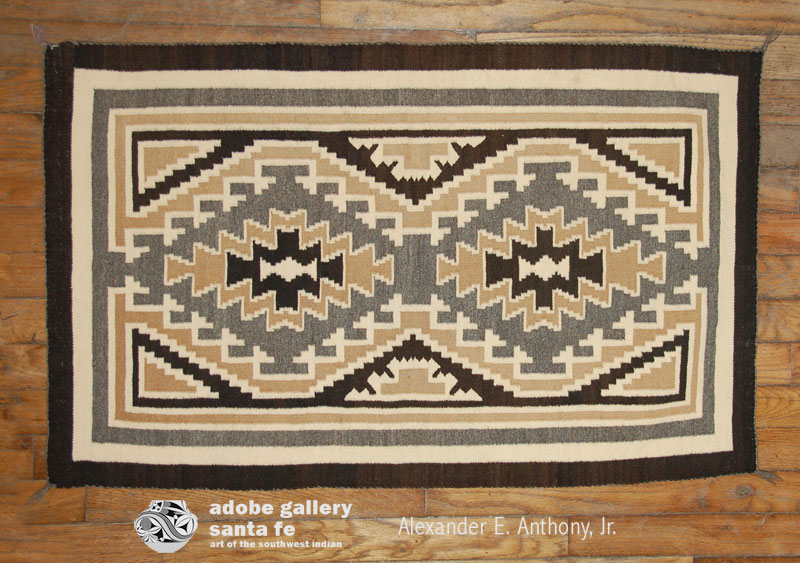 Two Grey Hills Trading Post is over a century old, and one of the few remaining historic posts on the Navajo Indian Reservation. It is the primary source of authentic regional rugs and tapestries. Made of hand spun yarn from the fleece of naturally colored local sheep in shades of gray, brown, black and white, they are known around the world as the finest in Navajo weaving.
Two Grey Hills Trading Post is over a century old, and one of the few remaining historic posts on the Navajo Indian Reservation. It is the primary source of authentic regional rugs and tapestries. Made of hand spun yarn from the fleece of naturally colored local sheep in shades of gray, brown, black and white, they are known around the world as the finest in Navajo weaving.
Since the early 1900s the weavers in the Two Grey Hills region, with the guidance of the traders, have produced rugs that are recognized everywhere as the pinnacle of the art. Artists there have challenged each other to spin the tightest yarns and to create the most intricate designs on their looms. Their trademark colors are the natural colors of the local sheep; grays and browns, white and black.
Would you like to purchase or know more?
Hopi Pueblo Third Mesa Wicker Eagle Large Plaque - 25496
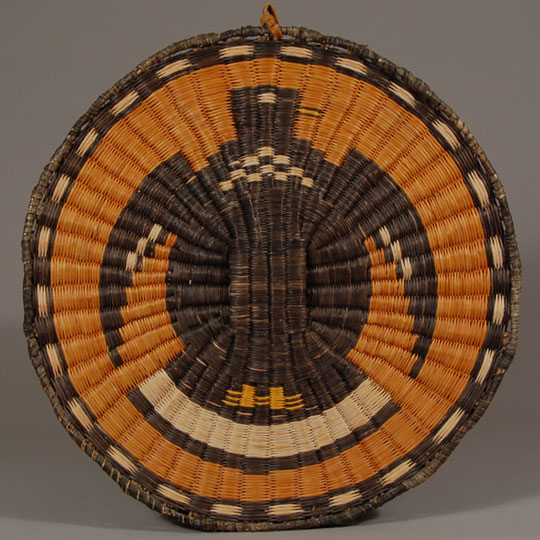 This basket features a large, prominent eagle as the focal design. The eagle is very important to all Native peoples, and the Hopi are no exception. The eagle is used in a number of religious ceremonies and its feathers are used in pahos (prayer sticks), on Katsina and Katsina dolls, and in home altars. The Hopi have the utmost respect for eagles.
This basket features a large, prominent eagle as the focal design. The eagle is very important to all Native peoples, and the Hopi are no exception. The eagle is used in a number of religious ceremonies and its feathers are used in pahos (prayer sticks), on Katsina and Katsina dolls, and in home altars. The Hopi have the utmost respect for eagles.
Historic Hopi Pueblo Polychrome Jar by Nampeyo of Hano - C3893B
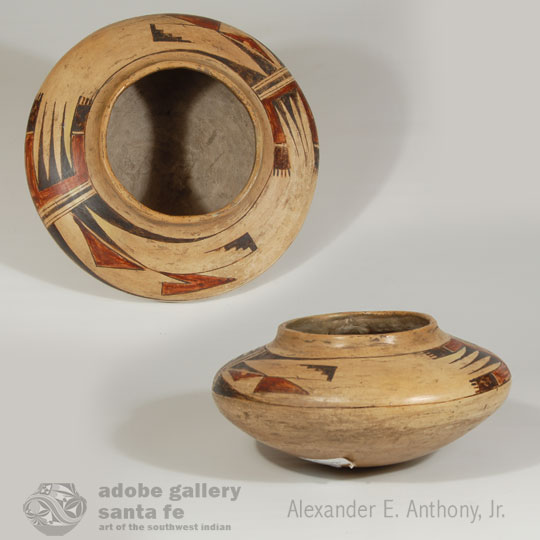 It is quite likely that Lester purchased Hopi pottery from Hubbell at Ganado. This jar, bearing his paper label could not have been sold by Lester after 1914, the year he moved to California. If it was made in the first decade of the 20th century, as we suspect, it was most certainly made by Nampeyo of Hano.
It is quite likely that Lester purchased Hopi pottery from Hubbell at Ganado. This jar, bearing his paper label could not have been sold by Lester after 1914, the year he moved to California. If it was made in the first decade of the 20th century, as we suspect, it was most certainly made by Nampeyo of Hano.
The jar bears resemblance to many of Nampeyo's jars with a wide mid-body and a short rising rim that rolls outward just so slightly. The design on the shoulder was arranged in a beautiful style and the painting was applied with extreme precision. The rectangular element suspended from the design is a variation of the Sikyatki bird design used by Nampeyo on many examples of her pottery. The extension of the fine black line from the upper and lower designs serves to provide upper and lower framing lines.
Would you like to know more or purchase?
Kewa (Santo Domingo) Pueblo Pottery Serving Bowl - C3317B
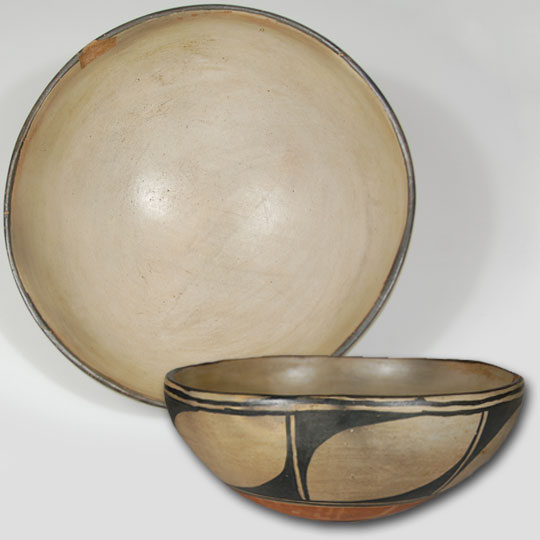 Santo Domingo Polychrome is a typology designation that has been used for over a hundred years. Now that the pueblo has gone back to using its ancestral name, there could be some confusion as to whether Santo Domingo Polychrome or Kewa Polychrome is the correct typology designation. Most likely, Santo Domingo Polychrome will continue to be used until there is an official recognition of a typology name change.
Santo Domingo Polychrome is a typology designation that has been used for over a hundred years. Now that the pueblo has gone back to using its ancestral name, there could be some confusion as to whether Santo Domingo Polychrome or Kewa Polychrome is the correct typology designation. Most likely, Santo Domingo Polychrome will continue to be used until there is an official recognition of a typology name change.
This Kewa Pueblo Pottery Serving Bowl is typical of the size of a serving bowl. It is slipped on the interior with a stone polished cream finish, has a black rim, and natural stone-polished underbody with a rag-wiped red band just below the design field.
Would you like to know more or purchase?
#adobegallery #SouthwestIndianPottery #KewaPueblo #SantoDomingoPueblo #KewaPottery #SantoDomingoPueblo #PuebloPottery #SouthwestIndianArt #SantaFePottery #FinePuebloPottery #HistoricPottery
Visually Strong Navajo Rug circa 1920s - C3891C
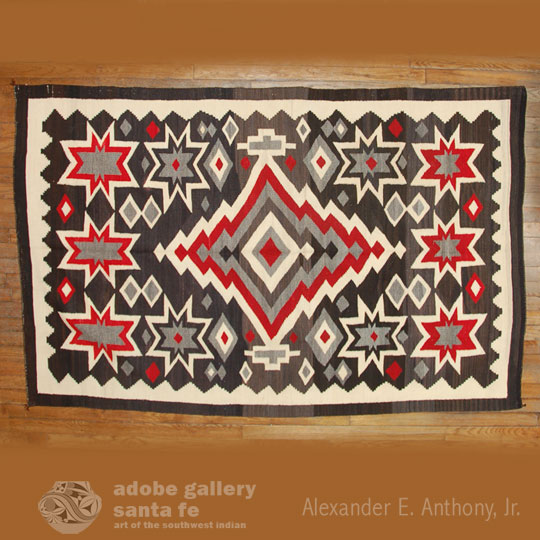 This is an amazingly visually strong pattern on a Crystal Trading Post textile. It was woven from all hand-spun Native wool with only red aniline dye. The center design appears to be in the process of enlarging into an explosive moment. The grey, red, and white zigzag lines seem to vibrate. The dark brown variegated wool is deep in color and reminiscent of a night sky. The Vallero Stars float on the night sky as twinkling lights.
This is an amazingly visually strong pattern on a Crystal Trading Post textile. It was woven from all hand-spun Native wool with only red aniline dye. The center design appears to be in the process of enlarging into an explosive moment. The grey, red, and white zigzag lines seem to vibrate. The dark brown variegated wool is deep in color and reminiscent of a night sky. The Vallero Stars float on the night sky as twinkling lights.
Ganado Trading Post Late Transitional Period Navajo Rug - C3891B
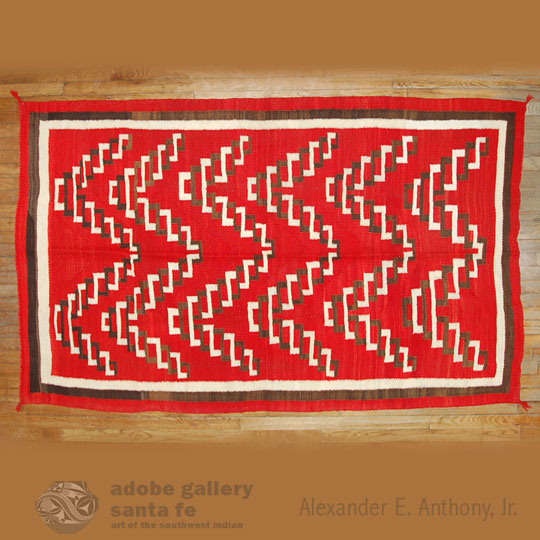 Before the arrival of the Spanish to the Southwest, the Pueblo Indians were weaving their own clothing. Weavers at Hopi, Zuni, Jemez and Acoma have been particularly recognized for fine weaving with native cotton. At Hopi, men were weavers. After the arrival of the Spanish, who brought sheep with them, the Navajo became the famous weavers, but it was the women who were the weavers. It is said that the Navajo learned to weave from the Hopi, particularly from those who were captured by the Navajo.
Before the arrival of the Spanish to the Southwest, the Pueblo Indians were weaving their own clothing. Weavers at Hopi, Zuni, Jemez and Acoma have been particularly recognized for fine weaving with native cotton. At Hopi, men were weavers. After the arrival of the Spanish, who brought sheep with them, the Navajo became the famous weavers, but it was the women who were the weavers. It is said that the Navajo learned to weave from the Hopi, particularly from those who were captured by the Navajo.
The Navajo women were weavers of fine wearing blankets and serapes. They became extraordinarily proficient in making the finest textiles imaginable. The weave was tight and the patterns were beautiful.
Would you like to know more or purchase?
Navajo Silver and Turquoise Bracelet with Three Discs - C3864.14
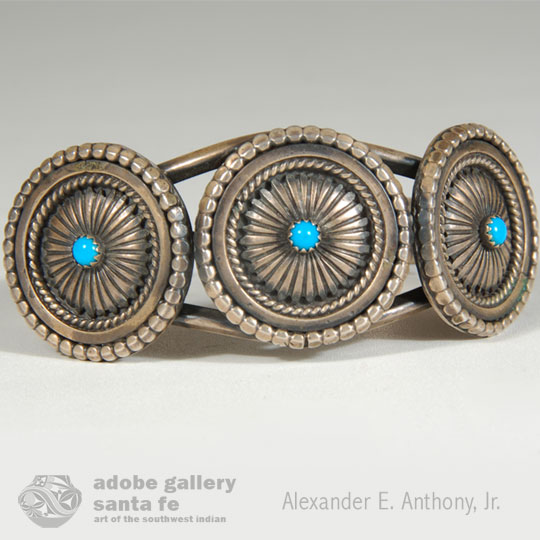 The foundation of this bracelet consists of three silver flat strips spread at the center and soldered at the ends. The foundation supports three silver conchas, each highly decorative and each with a small turquoise cab. The bracelet is stamped with the initials RB enclosed in a line drawing of a bear. This hallmark sign is not included in any of my hallmark reference books, so the artist is probably a young person who was not active when the books were compiled. The Silver and Turquoise Bracelet with Three Discs does have the look of being relatively new.
The foundation of this bracelet consists of three silver flat strips spread at the center and soldered at the ends. The foundation supports three silver conchas, each highly decorative and each with a small turquoise cab. The bracelet is stamped with the initials RB enclosed in a line drawing of a bear. This hallmark sign is not included in any of my hallmark reference books, so the artist is probably a young person who was not active when the books were compiled. The Silver and Turquoise Bracelet with Three Discs does have the look of being relatively new.
Tohono O´odham - Papago Tribe Cylindrical Basket - C3876Q
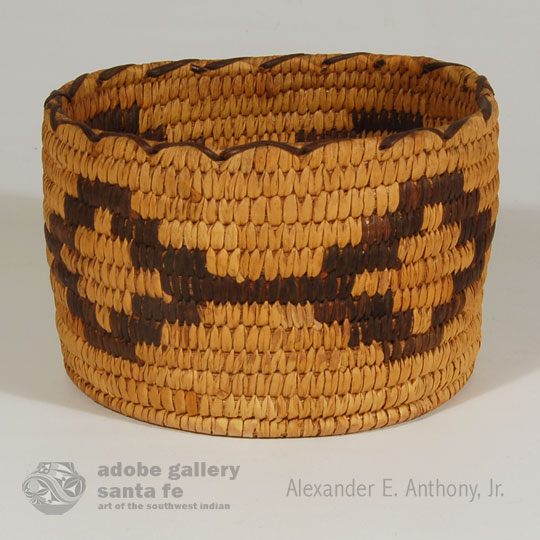 The Tohono O'odham have rejected the former name Papago, used by Europeans after being adopted by Spanish conquistadores from hearing other Piman bands call them Ba:bawĭkoʼa. The Pima (Akimel O'odham) were competitors and referred to the people as Ba:bawĭkoʼa, meaning "eating tepary beans." That word was pronounced Papago by the Spanish and adopted by later English speakers.
The Tohono O'odham have rejected the former name Papago, used by Europeans after being adopted by Spanish conquistadores from hearing other Piman bands call them Ba:bawĭkoʼa. The Pima (Akimel O'odham) were competitors and referred to the people as Ba:bawĭkoʼa, meaning "eating tepary beans." That word was pronounced Papago by the Spanish and adopted by later English speakers.
This cylindrical basket is one probably made in the pre-World War II period, to be sold to the tourist market. It is too small to serve a function in a Native home. The basket has a rich warm patina which attests to its age. It has a design of stepped squares hooked to adjoining ones in chain-like manner. The yucca is wrapped over a grass bundle and the design is made from the wild plant, Devil's Claw.
Very Large Historic Ohkay Owingeh Pueblo Shallow Polished Red Bowl - C3889B
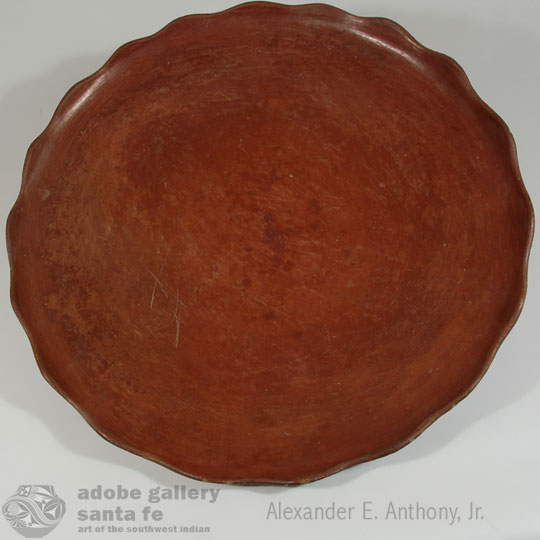 Ohkay Owingeh Pueblo had a strong tradition of plainware pottery production prior to 1900. Pottery styles included Black-over-gray and Red-over-tan, the difference being only from the firing technique. Pottery had slip applied only partially, usually the upper half, in red clay. If fired in an oxidizing atmosphere, the result was Red-over tan, the tan being the natural color of the clay body. If fired in a reduction firing, the result was Black-over-gray, the gray resulting from the firing effect on the natural tan clay body.
Ohkay Owingeh Pueblo had a strong tradition of plainware pottery production prior to 1900. Pottery styles included Black-over-gray and Red-over-tan, the difference being only from the firing technique. Pottery had slip applied only partially, usually the upper half, in red clay. If fired in an oxidizing atmosphere, the result was Red-over tan, the tan being the natural color of the clay body. If fired in a reduction firing, the result was Black-over-gray, the gray resulting from the firing effect on the natural tan clay body.
Those two styles of pottery were the extent of pottery production at the pueblo. The lack of painted designs was the reason such vessels were so beautiful. Vessel shape and high burnish were the traits that brought out the beauty of each jar or bowl.
San Ildefonso Pueblo Black-on-black Feather Design Plate signed Maria/Popovi - C3890A
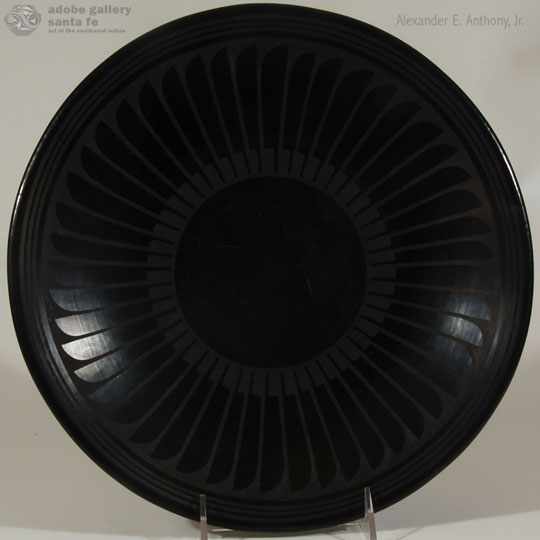 Popovi Da began collaborating with his mother on her pottery in 1956, following a period when Santana had been assisting her mother-in-law. Popovi and his mom worked together until his death in 1971. Popovi worked with Maria in all aspects of pottery preparation and their pieces were co-signed. When Popovi passed away, Maria essentially retired. Popovi initiated the process of adding the date to his and Maria's pottery in 1959. Prior to that, they were just co-signed with the two names.
Popovi Da began collaborating with his mother on her pottery in 1956, following a period when Santana had been assisting her mother-in-law. Popovi and his mom worked together until his death in 1971. Popovi worked with Maria in all aspects of pottery preparation and their pieces were co-signed. When Popovi passed away, Maria essentially retired. Popovi initiated the process of adding the date to his and Maria's pottery in 1959. Prior to that, they were just co-signed with the two names.
This plate with a feather design does not have a date so it would have been made between 1956 and 1958, the period before dates were placed on their pottery. It is this period, when Maria was assisted by her son, which most collectors herald as the greatest period of creativity.
Zuni Pueblo Multi-stone Three-strand Fetish Necklace - 25749
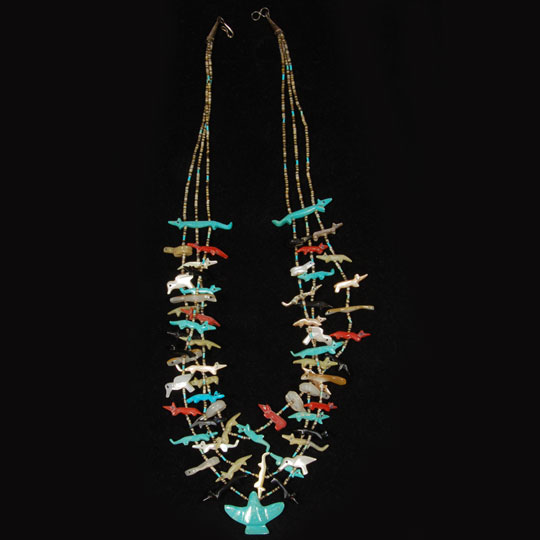 This exceptional Zuni Pueblo fetish* necklace is comprised of three strands, each of a different length arranged in such a manner that each strand can be viewed without overlapping another. The longest strand contains 21 fetishes carved from jet, coral, mother-of-pearl, turquoise, and abalone. The middle strand contains 19 fetishes carved from the same stones and maybe others. The shortest strand contains 18 fetishes carved from similar stones. The fetishes are strung about an inch apart on shell and turquoise hieshe. The three strands are separated at each end by a turquoise fox fetish. The three strands are held together at their ends with silver cones and a silver clasp.
This exceptional Zuni Pueblo fetish* necklace is comprised of three strands, each of a different length arranged in such a manner that each strand can be viewed without overlapping another. The longest strand contains 21 fetishes carved from jet, coral, mother-of-pearl, turquoise, and abalone. The middle strand contains 19 fetishes carved from the same stones and maybe others. The shortest strand contains 18 fetishes carved from similar stones. The fetishes are strung about an inch apart on shell and turquoise hieshe. The three strands are separated at each end by a turquoise fox fetish. The three strands are held together at their ends with silver cones and a silver clasp.

